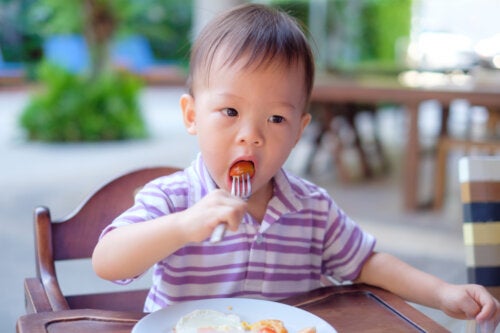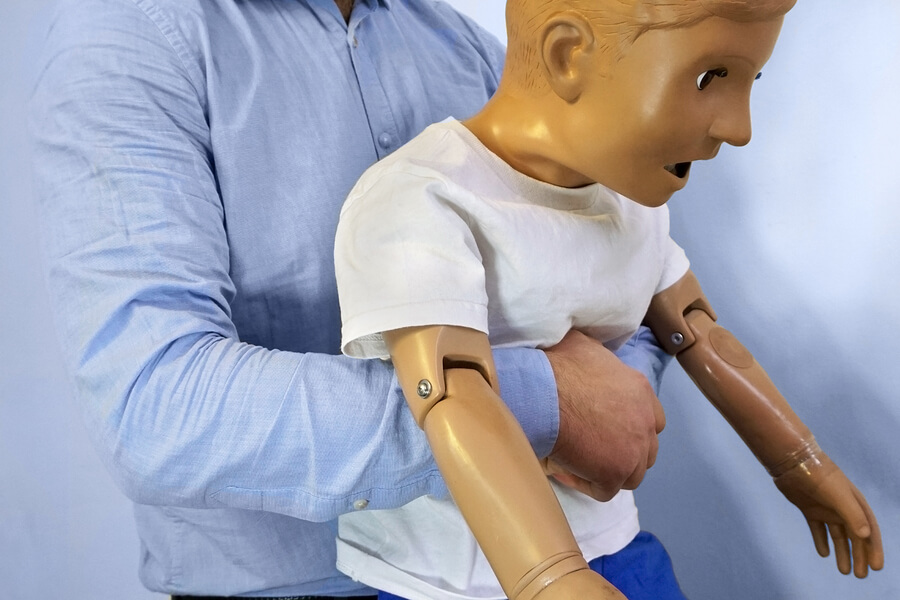4 Foods that Are a Choking Hazard
There are a number of foods that present a choking hazard and shouldn't be offered to young children. Find out what they are.

There are some foods that involve a high risk of choking and, therefore, special attention must be paid to them until the child’s swallowing reflex is completely efficient. Giving children foods that are a choking hazard could endanger their life.
To avoid making mistakes in this matter, it’s advisable to carefully read the tables for the introduction of foods in the context of complementary feeding.
Also, adapt the presentations and preparations of certain “dangerous” foods so as not to have to do without any of them completely. It should be noted that a nutritional or energy deficiency at this time of life could also affect the body and the health of the child.
Foods that are a choking hazard
Complementary feeding is a time of learning. It’s the first contact with the culinary world and the gateway to healthy habits.
Letting infants experiment with their hands and discover their tastes and preferences on their own is a great stimulus. However, it requires a lot of attention, dedication, and presence on the part of parents or caregivers, both in the preparation of meals and when offering them to children.
Below, we‘re going to show you some foods with a high risk of choking. Many of them shouldn’t be offered to children until they’re 4 or 5 years old to avoid accidents. But others can be included in their diet if the preparation and the way of offering them to the little ones are adapted. Take note!

1. Whole nuts
Nuts are very high quality foods, as they contain some proteins and fats that are essential for maintaining good health. Some of the latter, such as omega-3 oils, have been shown to contribute to the functioning of the cardiovascular system and reduce inflammation.
However, due to their organoleptic characteristics, whole nuts can easily cause choking. Because they’re hard edibles, they’re difficult to chew and handle in the mouth. Especially, if we think about an infant’s mouth.
To avoid this problem without giving up their nutrients, you can choose to elaborate suitable preparations, such as nut creams, or grind them and include their flours in a pudding or cake.
One last fact about nuts is that they’re quite allergenic and for this reason, they should be introduced into your baby’s diet with certain precautions. Consult your pediatrician before incorporating them so that they can advise you in the best way.
2. Gummies
Due to their size, consistency, and texture, gummies and chewing gum could cause choking in the little ones. In addition, they’re products that don’t provide any benefit in terms of nutrients. In fact, they contain an excessive amount of simple sugars, which increases the risk of metabolic diseases when consumed frequently.
Our recommendation is to avoid them as much as possible and in case you offer them to your children, supervise them at all times while ingesting them.
3. Raw carrots
Those foods that are offered uncooked should have a soft consistency in order to be easily chewed by little ones before swallowing.
Some edibles, such as raw carrots or apples, as well as hard pieces of meat, require a lot of coordination of the mouth structures and a huge muscular work to elaborate the food bolus. This makes children tired and they try to swallow prematurely, which increases the risk of these pieces of food ending up in the airway.
In order to avoid complications, offer these vegetables cooked (steamed or boiled) to soften them and in the case of meats, opt for more tender and less fibrous cuts.
4. Grapes
Fruits are recommended in the diet from the very beginning. However, some of them can be a choking hazard due to their roundness, their small size, or the presence of seeds inside. For example, grapes, peas, and cherry tomatoes.
To avoid this problem, they can be offered peeled, cut in the middle, and seedless.

Beware of foods that are a choking hazard
As you’ve seen, there are a number of foods that are choking hazards with which you should be cautious so as not to put your children’s health at risk. Depending on the food, it’s best to avoid them or adapt them until they’re able to handle them correctly in the mouth.
Finally, keep in mind that when the goal is to take care of the proper functioning of the body, a varied and complete dietary pattern with a predominance of fresh foods should be considered. These have high-quality nutrients that can benefit the development and growth of your children much more than you think.
